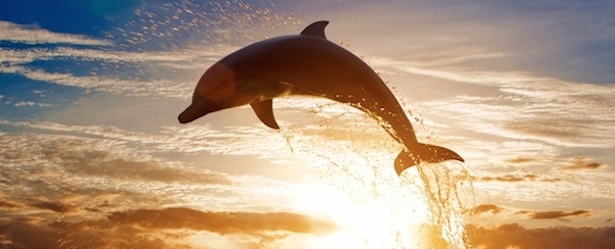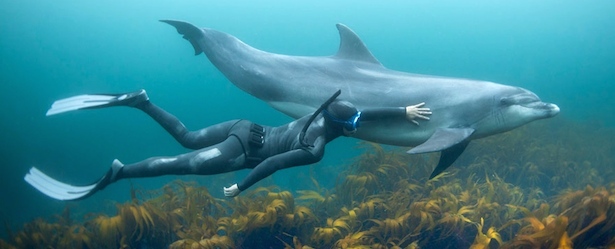
There are few beings on Earth as majestic as the dolphin. If you’ve got a heart I’m sure you’ve felt it: the sense of joy that comes from beholding the playful and intelligent essence of the Caribbean dolphins. They’re said to be of divine intelligence and they certainly radiate some sort of special allure. When many of us imagine a perfect tropical vacation there’s a scene where you’re swimming in the warm waters with the dolphins. Well as it turns out, there are many places in the wilds of the Caribbean where you can do just that. So let’s look a bit deeper into the lives of these remarkable animals.
Dolphins are cetacean mammals, which derives from the Greek word kētos which means “whale or any huge fish or sea monster”. And while science has shown dolphins to not be sea monsters, they are part of the whale family. And as whales, they’re noted for their high level of intelligence – both intellectual and emotional. As of 2012, the American Association for the Advancement of Science (the planet’s largest science conference) voiced support for a cetacean bill of rights, effictively listing dolphins and whales as non-human persons. India took the lead in 2013 (followed by Chile, Costa Rica and Hungary), officially declaring dolphins and whales as non-human persons and subsequently banning their use in captivity – a huge win for animal rights activists and people who recognize that obviously these creatures are more magnanimous than we’ve been led to believe and are just as deserving of every right to exist as we are.
Anyways, these beautiful beings come in forty different species and vary in size from an adorable 1.2 m (4 ft) to a whopping 9.5 m (30 ft) in length. The big bruiser there is actually the orca, which fits into the dolphin family, or Delphinidae, if we’re being specific. The common distinction outside of zoology geeks circles sees dolphins as the smaller whales with the long noses. Regardless, they all crawled into the ocean at one point – or so mainstream evolution believes – stemming off from a common terrestrial ancestor. Strange pelvic bones that seem to serve no clear purpose give credence to this idea of dolphins once having legs. Imagine that.
Speaking about anatomy, inside the dolphin’s head is something called the “melon” (yes!) which is the organ responsible for the famous echolocation skill. Also called bio sonar, this amazing feature allows dolphins to transmit signals out into the environment that bounce of off objects in echo form, which are then picked up by the teeth and interpreted as distance. Dolphins breathe air through their blowhole which is one of the reasons you’ll see them leaping out of the water. Another cool feature about the dolphin is their regenerative healing ability. While science can’t explain how it happens, dolphins can tolerate and recover from extreme injuries like shark bites in a way that rapidly restores even the most gaping of wounds to a normal body shape. Wow.

As you could imagine, Caribbean dolphins (and all cetaceans) also have highly developed senses. Not only do they have sharp eyesight and hearing capabilities 10 times that of humans, and the whole mysterious echolocation thing, but they’ve also got a well developed sense of touch all around the body and especially the nose. Adding this to the fact that dolphin is one of the planet’s most intelligent animals (relatively speaking it’s hard to pinpoint the ‘smartest’), and you’ve got yourself one phenomenal creature there.
They’re highly social, living in pods of up to a dozen dolphins and occasionally form a superpod of up to 1,000 dolphins, kind of like a big ol’ family reunion. They communicate with clicks and whistles in what may very well be a language. Dolphins are known to use tools and they teach their young advanced techniques on how to use various tools in what can be construed as a form of culture. Their signature whistles are individual to each dolphin and are used like a name, in that other dolphins mimic the whistle to address another. They also communicate with each other telepathically. Their echolocation clicks are also among the loudest sounds made by marine animals. Dolphins are known for their playful nature and will partake in fun games like pass with various obje cts or dragging birds under water just to mess with them.
cts or dragging birds under water just to mess with them.
Relationships with Humans
Way before Flipper people have been engaged in connections with dolphins, from symbolism to mythology to use as omens. They are legendary for rescuing humans who are lost out at sea and drowning, or like divine messengers showing them the way back to safety like guides through treacherous waters. Since Ancient Greece, dolphins have been recorded rescuing people from sharks or other dangers and up to the present day these occurrences happen surprisingly often. They’re almost like guardian angels of the deep for people and indeed we do seem to share some special bond.
At the core of its symbolism, dolphins represent grace. Other meanings and lessons learned from the dolphin include playfulness, transcendence, gentleness, and harmony. The dolphin’s compassion comes as a message of wellbeing to the pure of heart and a reminder to live as such. As they are both of the water yet breathe air, a fish yet a mammal, the symbolism speaks to duality and the concept of yin/yang. In this way, dolphins inspire balance in us. They inspire us to do what we love to do and return (at least every now and then) to our playful state of creativity.


